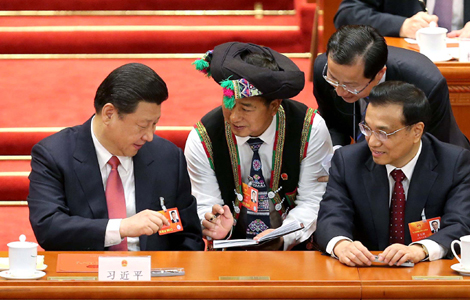Escape middle-income trap to achieve social fairness, sustainable development
BEIJING - China has transformed from a borderline to a middle-income country thanks to its 30 years of reform and opening-up, and is striving to build an all-round well-off society.
To achieve that goal and sustain growth, China must address one of the huge, urgent but inevitable challenges -- the middle-income trap. That's when a middle-income country is unable to make the next leap to a high-income nation because problems such as unfair income distribution and excessive disparity in income stop its social and economic development.
World Bank statistics show that only 13 of the 101 countries and regions that entered the middle-income stage in 1960 escaped the middle-income trap. Those numbers also manifested how tough the task was for China, whose GDP per capita, according to the World Bank, reached 4,920 US dollars in 2011.
In addition, there is no ready example for China, the world's second largest economy, to follow as the 13 economies that avoided being ensnared are much smaller. China should be innovative, taking into account its own national conditions, to create a suitable development road.
Nevertheless, history does sometimes repeat itself. China can learn from some typical and common experiences and lessons of those who have been in the same boat.
In Latin America, entrapped countries have almost all experienced changed external environments and slowing economic growth. They also have faced grave disparity between the rich and the poor, visible social conflicts and powerful but defiant vested interests.
All these woes usually dented governments' ambition and courage to carry on reform, which in turn led to repeated political and social unrest.
At a superficial level, these countries' failure to make additional breakthroughs was blamed on insufficient domestic demand. Virtually, the root cause lay with unfair income distribution and excessive disparity in income.
The gini co-efficient, a measure of social inequality, of the middle-income Latin American nations entrapped in 1970s, remained stubbornly high, well above the 0.4 warning level set by the United Nations. The level was also viewed by experts as the point at which social tensions could come to a head.
Cheng Siwei, president of the China Latin America Friendship Association, says that some problems faced by Latin American countries in the past now confront China, whose Gini co-efficient has exceeded 0.4 over the past five years.
On the other hand, when eyeing the middle-income countries that successfully moved on to the top row, such as Singapore and South Korea, one will find that they have attached great importance to education,technological innovation and social fairness.
South Korea's GDP per capita soared to nearly 20,000 dollars in 2010 from as low as 87 dollars in 1962. But its Gini co-efficient was a mere ? 0.33 in 1980 and 0.31 in 2010, according to The Economist magazine.
Policies adopted by the government to promote tax reform, equal education opportunities, employment and a social security system have efficiently narrowed the rural-urban and income disparities, achieving an "inclusive growth."
All the lessons and experience stressed that a package of political and social measures would safeguard justice and fairness and improve governance in a bid to avoid the income trap.
In the transition process, a government should play a leading role and do its part. The World Bank says that an active and efficient government is one of the five common characteristics of the 13 economies keeping clear of the trap.
Justin Yifu Lin, a former senior World Bank vice president, has said developing countries' efforts to catch up with or overtake the developed ones depends on how active their government is.
Aware of the potential risks and committing itself to building an all-round well-off and harmonious socialist society, the ruling Communist Party of China (CPC) at its 18th National Congress in November set out a development roadmap to pursue more vigorously inclusive growth, comprehensively implement rule by law and safeguard social justice and fairness to make sure that the Chinese people can benefit more and better from development dividends.
Such a campaign is being steadily and energetically pushed ahead as the annual sessions of the National People's Congress (NPC), China's parliament, and the National Committee of the Chinese People's Political Consultative Conference (CPPCC), the top political advisory body, which kick off March 5 and March 3 respectively, are to discuss and turn the ruling party's proposals into national policies.


